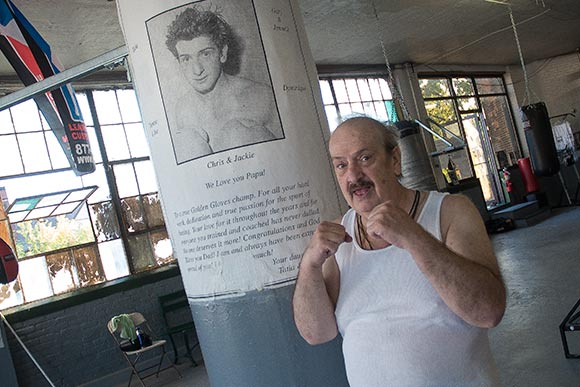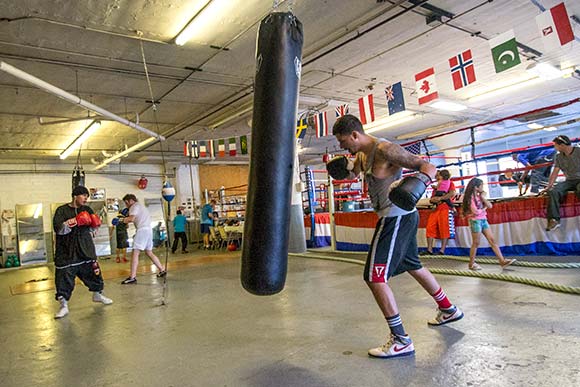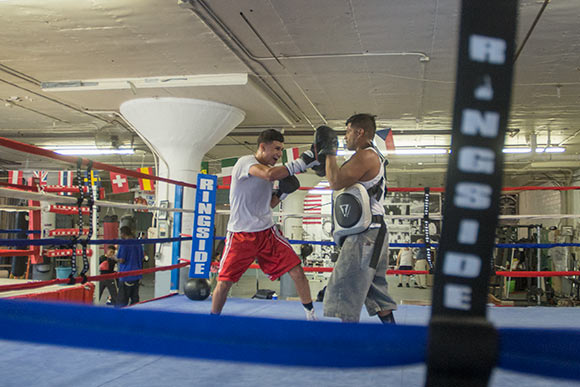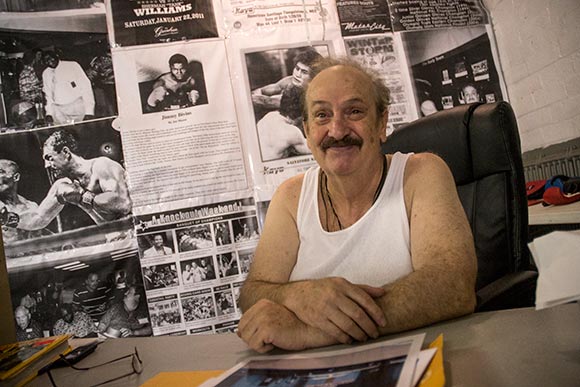boxing gyms offer a rich -- if incomplete -- refuge from inner-city struggles
A deafening belch echoes through the boxing gym, followed by peals of teenage laughter.
“All right guys, you gotta hold that in now,” calls Gary Horvath, the gym’s owner. “That’s rude.”
The belch’s perpetrator -- a boy in his early teens -- rolls his eyes and flops onto the bouncy floor of a boxing ring. A friend lands on top of him. The giggling continues, but the belching stops.
Without missing a beat, Horvath turns to slap hands with a man in his 30s who’s just finished his workout and is heading toward the door. “Lock up on your way out, would you buddy?” he says. “Just the doorknob.”
 Owner Gary Horvath then and nowHorvath, 67, is owner and founder of the Make Them Pay/Old Angle Boxing Gym, on the second floor of a century-old warehouse on West 25th Street in the Clark-Fulton neighborhood.
Owner Gary Horvath then and nowHorvath, 67, is owner and founder of the Make Them Pay/Old Angle Boxing Gym, on the second floor of a century-old warehouse on West 25th Street in the Clark-Fulton neighborhood.
At first glance, he’s the very picture of hard-bitten boxing survivor -- the kind you see in movies chomping cigars and barking commands at trainees. He sports an imposing waistline and there’s a gaping hole where his two bottom teeth should be.
But Horvath, as he’ll be the first to tell you, is actually a softie. He presides over his cavernous gym like a benevolent mayor. He knows everyone by first name and isn’t afraid of a good bear hug.
“Everyone thinks boxing is so tough,” he says. “But it’s not. People don’t realize how intimate it is -- not just between the fighters, but between the trainer and the boxer. It’s an art.”
 Old Angle Boxing GymIt’s clear from even a casual visit that his gym functions not just as a training facility but as an especially vibrant “Third Place” -- a term social scientists use to describe a location outside home, work or school where people congregate to socialize and let off steam. (Coffee shops, bars and parks are other examples.)
Old Angle Boxing GymIt’s clear from even a casual visit that his gym functions not just as a training facility but as an especially vibrant “Third Place” -- a term social scientists use to describe a location outside home, work or school where people congregate to socialize and let off steam. (Coffee shops, bars and parks are other examples.)
Huge windows flood the space with natural light. All around, there’s the constant thud and grunt of boxers punching bags, the thwap-thwap of jump ropes.
Boys and girls alike flock here after school lets out, along with men and women in their 20s, 30s and beyond. Many live in the surrounding neighborhood, an ethnically diverse blue-collar enclave that’s long grappled with crime and disinvestment.
Taliah Hughley, 15, watches a sparring match between two adult male boxers in one of the gym’s two rings. Both men have gone pro, earning -- after promoters take their cut -- up to a few thousand dollars per bout. The promise of making a living or partial living from boxing helps keep teen and young adult boxers motivated, particularly in a neighborhood like Clark-Fulton, where median household incomes hover around $25,000, according to data from NEOCANDO.
Hughley’s eyes dart between the two men as she chews the drawstring of her pink hoodie. Her dad first introduced her and her older brother to the sport, she says. When her brother died a few years ago in a car wreck, she kept boxing to honor his memory.
“I also like it because it’s a way to take out my anger,” she says. “You know, about stupid stuff other kids say at school or whatever.”
Does she get nervous stepping into the ring? “At first, yeah,” she says, then smiles. “But I get over it fast once the other person starts taking swings at me.”
 Old Angle Boxing GymOld Angle is just one of a constellation of boxing clubs and gyms across the city -- some operating out of permanent space, some rotating through city recreation centers and ad hoc private spaces. Most keep a low profile and operate on a shoestring budget. Coaches and owners make little or no money up front, particularly since many trainees can’t afford to pay for training -- though there’s a chance of cash flow later if a young boxer decides to go pro.
Old Angle Boxing GymOld Angle is just one of a constellation of boxing clubs and gyms across the city -- some operating out of permanent space, some rotating through city recreation centers and ad hoc private spaces. Most keep a low profile and operate on a shoestring budget. Coaches and owners make little or no money up front, particularly since many trainees can’t afford to pay for training -- though there’s a chance of cash flow later if a young boxer decides to go pro.
The Untouchable Boxing Academy is a roving club that uses city recreation centers across Cleveland’s East Side. It’s run by Chuck Conwell, a former boxer who lives at King Kennedy Estates, a public housing property in Central, one of the city’s poorest neighborhoods.
On a recent weeknight, Conwell and about a dozen boxers -- girls and boys, ranging in age from 8 to 22 -- pack into a cramped, windowless room inside Cory Recreation Center on East 105th Street. Old news articles about 1920s boxing icon Jack Dempsey paper the walls.
Conwell, 46, straps gloves onto a husky 22-year-old male fighter who’s just returned to boxing, then pushes him into the ring with a thinner but more experienced 18-year-old. The mismatch, he says, is important to keep the newer boxer from becoming discouraged.
A bell rings, and the two circle each other, taking tentative jabs.
“Don’t try to match him, Peanut,” Conwell calls, using his nickname for the older boxer. “Just fight your fight.”
Like Horvath, Conwell sees himself as a surrogate dad to his young fighters. It’s a role he says compels him because he felt the absence of a mentor during his own childhood.
“Most of the kids I deal with, the father’s not in the home,” he says. “Or if he is, he’s not supportive. I didn’t have a support system when I was young. I always had the desire but I never had the push -- from a father, uncle, coach. So that’s what I try to give.”
That level of commitment is a common thread among local coaches and gym owners, says Adam Stalder, economic development director for the Clark-Fulton neighborhood development organization. Aside from Old Angle, Stalder has worked with two other boxing gyms in his neighborhood, helping them secure space and obtain city permits.
“These guys make barely any money, so they have to work really hard to keep their doors open,” he says. “Often, they end up in underdeveloped areas because they need cheap space and they need a lot of space.”
 Gary Horvath owner of the Old Angle Boxing GymHorvath, for example, bootstrapped his gym into existence through personal savings, a supply of old equipment he had on hand and a $13,000 sponsorship from Tim “Make Them Pay” Misny, a personal injury lawyer. (Misny’s slogan constitutes half the name of Horvath’s gym. The other half, Old Angle, honors a now-demolished gym of the same name near West 25th and Detroit where Horvath trained in his youth.)
Gary Horvath owner of the Old Angle Boxing GymHorvath, for example, bootstrapped his gym into existence through personal savings, a supply of old equipment he had on hand and a $13,000 sponsorship from Tim “Make Them Pay” Misny, a personal injury lawyer. (Misny’s slogan constitutes half the name of Horvath’s gym. The other half, Old Angle, honors a now-demolished gym of the same name near West 25th and Detroit where Horvath trained in his youth.)
Stalder can see a time when, if development pressure continues to march south down West 25th Street from Ohio City, the gyms in Clark-Fulton may need to consider moving. MetroHealth Hospital, just across the street from Old Angle, is completing a master plan that seeks to redevelop West 25th as the hospital’s urban front door.
“Our position is, we’ll help the gyms if they ever do have to move,” Stalder says. “These places keep kids occupied during that crucial period between when they get out of school and when their parents get home from work. They serve a real purpose in the neighborhood.”
Lucia Trimbur, a sociology professor at John Jay College in New York City, has studied the role of boxing gyms in post-industrial cities. She says gyms provide a “necessary but not sufficient” way of filling the gaps in social support that often exist in low-income neighborhoods -- a lack of child care, for example, or household instability.
“It’s heartwarming and important to know that gyms can fill in some of those missing pieces,” Trimbur says. “But we shouldn’t forget there’s also something missing, which is a more systematic way of helping people through those struggles in the first place -- even if it’s simply completing school.”
Horvath, for his part, takes obvious pride in his role of neighborhood caretaker. As closing time nears, he studies the adult and kid boxers filing downstairs to the tough neighborhood outside.
“I don’t want anyone hurt in here,” he says. “Physically, the way you look when you come up my stairs, you should look the same way going down. And I hope you can hold your chin a little higher, too.”








